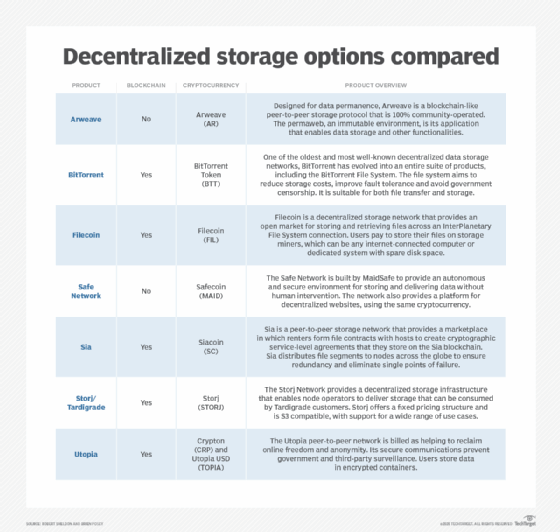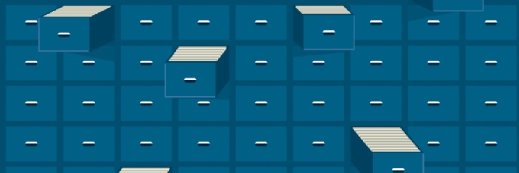
Getty Images
Compare 7 decentralized data storage networks
Decentralized storage offers organizations an alternative to centralized cloud storage. While cost can be a benefit, support levels vary among some of the top vendors.
Decentralized data storage has emerged as a disrupter to traditional cloud storage and could represent a significant shift in the way organizations distribute and store data in the future.
Numerous companies already offer decentralized storage options, some of which use blockchain technology to facilitate storage operations and validate transactions across a distributed network.
What is a decentralized storage network?
With decentralized storage, data is encrypted and stored across multiple locations, or nodes, run by individuals or organizations that share their extra disk space for a fee. Essentially, a decentralized storage vendor often acts as a broker, matching those who need to store data with those who seek to lease their extra storage capacity. Regardless of where the data is stored, only the data's owner holds the private encryption key; storage providers cannot access the data. In many cases, the files are also sharded and spread across multiple locations, providing yet another layer of storage security.
Decentralized data storage products often use blockchain to track storage transactions. Blockchain is a distributed ledger technology that can automatically synchronize and validate storage transactions across distributed nodes. The blockchain ledger might record shard hashes, data locations, leasing costs or other transaction-specific information.
Decentralized storage network vendors
Decentralized storage has been gaining traction in recent years, and numerous options are already on the market. Most of these products rely on blockchain to support their storage strategies. Blockchain and decentralized storage aren't the same, however, and one can exist without the other. Here are seven decentralized data storage products to consider.
1. Arweave
While some of the other decentralized data storage offerings focus primarily on privacy or on avoiding censorship and monitoring, Arweave is designed for data permanence.
Arweave uses a proprietary blockchain technology called the blockweave. It's essentially a peer-to-peer (P2P) storage protocol that offers extra storage capacity available on PCs acting as Arweave clients. The application that enables data storage and other functionality is called the permaweb -- an immutable environment for storing webpages and other types of data, such as databases and static files. Those who wish to store data are required to pay a one-time fee using Arweave tokens, which are available from most crypto exchanges.
Arweave is 100% community-operated and is designed to work with Linux. It can be used on Windows but is not recommended for reliability reasons.
2. BitTorrent
BitTorrent is one of the oldest and most well-known decentralized data storage networks. Founded in 2001, BitTorrent initially gained notoriety as a platform for sharing pirated media. Over time, BitTorrent evolved into an entire suite of products, including BitTorrent File System (BTFS).
BTFS is a scalable decentralized storage system designed to reduce storage costs, improve fault tolerance and avoid government censorship. Like other distributed storage networks, BTFS relies on user nodes. One of the elements that distinguishes BitTorrent from some of the other networks, however, is the more than 100 million user nodes in place. Additionally, BTFS is blockchain-based and uses the TRON network. There are more than 1,000 full TRON nodes, with 27 block producers designated as super representatives. BTFS has over 600 petabytes of storage space available.
BTFS is a derivative of InterPlanetary File System (IPFS) and is suitable for both file transfer and storage. Unlike the other decentralized data storage offerings, however, BTFS is designed in a way that enables users to remove any illegal or copyrighted media from their nodes.
3. Filecoin
Filecoin is widely known for having had one of the largest initial coin offerings of all time, raising $257 million in 2017. Filecoin is a P2P network service that uses blockchain and native cryptocurrency to deliver storage services.
The cryptocurrency, referred to as FIL, supports all transactions. Users pay FIL to store their files. Miners, or storage node owners, earn FIL to store the files. The blockchain ledger records the transactions and provides proof that miners are storing files correctly. Filecoin is built on the IPFS distributed storage network but differs from that network in that Filecoin has added an incentive layer.
Filecoin pricing is not controlled by any single company; instead, it is an open market in which anyone can participate. Although this offers greater flexibility, it can make it difficult for organizations working within specific storage budgets, especially when trying to calculate gas fees, which are charges for resources consumed by on-chain message operations.
The Filecoin project is open source and encourages storage providers, consumers and developers to build apps on top of its file system. It is worth noting, however, that the Lotus nodes used by Filecoin are only supported on Linux and macOS. Windows is not supported.
4. MaidSafe and Safe Network
MaidSafe is a small team of individuals building the Safe Network, an autonomous global network made up of storage nodes. In doing so, MaidSafe sought to create a network that could not be turned off, blocked, censored or controlled.
Collectively, the software manages storage across the network, routing data and messages securely between the nodes. Nodes are clustered into sections that control the data stored within them. Section formation and data movement are all autonomous operations without the need for centralized servers, agents or human oversight.
Anyone can join the network anonymously as a provider, subject to a resource test, and anyone can store data or access public information on the network. The Safe Network project also provides an API that developers can use to interact directly with the network. The client software stores data on the Safe Network. The software divides the data into a minimum of three segments, hashes and encrypts the segments, and then applies additional protections. Multiple copies of each segment are stored within a section to ensure redundancy.
As it stands now, users purchase storage with MaidSafeCoin, which is available on several public exchanges. Those who sell spare storage capacity are also paid using MaidSafeCoin. Eventually, MaidSafeCoin will be replaced by Safe Network Tokens.
Those who need to store data can pay once but store data forever. The Safe Network acts as a secure, universally accessible alternative to the World Wide Web. It has a goal to eliminate corporate and government tracking.
5. Sia
Like Filecoin, Sia uses blockchain to provide a decentralized data storage platform that encrypts and distributes files across a global P2P network. The Sia client software -- available for Windows, Linux and macOS -- breaks each file into 30 segments, which it then distributes to different hosts.
The software uses Reed-Solomon erasure coding to ensure redundancy and make it possible to recover a file from only 10 of its segments. The software also uses the open source Threefish algorithm to encrypt the segments before sending them to the storage hosts. Renters use Siacoin to purchase storage, and hosts use Siacoin as collateral when storing files.
Sia software is completely open source and includes an API that developers can use when building applications. Setting up Sia -- as either a renter or host -- is a straightforward, well-documented process, which makes it stand out from some competitors.
Sia provides a decentralized storage marketplace in which storage providers compete for business. As a result, pricing is less predictable. Sia estimates the cost of storing 1 TB of data to be $1 to $2 per month. However, renters should be aware of additional costs, such as contract formation fees and bandwidth fees for uploading and downloading files. Like other coins, the value of Siacoin also fluctuates, meaning that real-world storage costs vary from one month to the next.
6. Storj and Tardigrade
Storj is one of Sia's top competitors and delivers similar services, including blockchain storage. Some confusion has surrounded Storj naming, however. Storj and Tardigrade referred to two different Storj Labs business areas. Storj focused on the supply side and Tardigrade on the demand side. Storj node operators provided decentralized storage to Tardigrade customers. Storj has since rolled its Tardigrade product under the Storj brand as Storj Decentralized Cloud Storage, according to the vendor.
Storj storage is S3-compatible, with data broken into smaller segments, encrypted using Advanced Encryption Standard-256 (AES-256) with Galois/Counter Mode symmetric encryption and stored across the global network, like Sia. Storj breaks files into 64 MB segments, with each segment made of 80 pieces that are sent to storage nodes. Only 29 of these 80 pieces are required when accessing the file, and the service uses the fastest available pieces.
According to Storj Labs, its storage is well suited to backups, archives, media content, hybrid cloud storage services, large file transfers, log files over 4 KB and database snapshots.
Unlike other services, Storj offers fixed pricing, making it easier to budget storage costs. As of February 2025, Storj charges $0.004 per GB per month, with a data egress fee of $0.007 per GB.
7. Utopia
The Utopia P2P network is designed to act as a tool for reclaiming online freedom and anonymity. It provides secure communications in a way that prevents government and third-party surveillance. Online communications are provided by Curve25519 high-speed elliptic curve cryptography, whereas local storage is encrypted with AES-256.
Utopia supports two different cryptocurrencies: Crypton and Utopia USD. Crypton is Utopia's preferred currency and is designed to be decentralized and untraceable, whereas Utopia USD is more stable because its value is tied to the U.S. dollar.
Utopia users store data in encrypted containers. Utopia defines an encrypted container as "encrypted, password-protected storage of your Utopia data, such as your private key, uMails, uWallet, files, chat history, contacts and transactions history." Utopia is available on Windows, macOS, Linux and Android.

What are the benefits of decentralized storage networks?
When an organization uses a decentralized network primarily for storage, the main benefit is cost. Decentralized data storage is typically based on leased excess capacity, so it tends to be inexpensive.
In many cases, decentralized storage networks are based on blockchain or similar technologies and deliver benefits such as data immutability, enhanced privacy and better overall security. Decentralized networks are resilient because the storage doesn't have a single point of failure.
What are the challenges of using decentralized storage networks?
One challenge with using decentralized data storage is simply the difficulty of getting stakeholder buy-in. Because of the way that decentralized storage networks were used early on, they gained a reputation for being amateurish and for being primarily used for software and media piracy. As such, enterprise stakeholders may have difficulty accepting the idea of using a decentralized storage network.
At least some networks rely on token-based -- or coin-based -- pricing. The purchasing department may be reluctant to approve payments to these types of networks. Even if an organization is not opposed to using these types of currencies, token prices can be volatile, so there is a potential for unexpected storage price spikes.
Other risks associated with using a decentralized storage network may include increased regulatory scrutiny, varying levels of performance -- depending on how many nodes are online -- and the potential for data loss if the provider goes out of business or if too many nodes go offline.
Brien Posey is a former 22-time Microsoft MVP and a commercial astronaut candidate. In his more than 30 years in IT, he has served as a lead network engineer for the U.S. Department of Defense and a network administrator for some of the largest insurance companies in America.
Robert Sheldon is a freelance technology writer. He has written numerous books, articles and training materials on a wide range of topics, including big data, generative AI, 5D memory crystals, the dark web and the 11th dimension.






